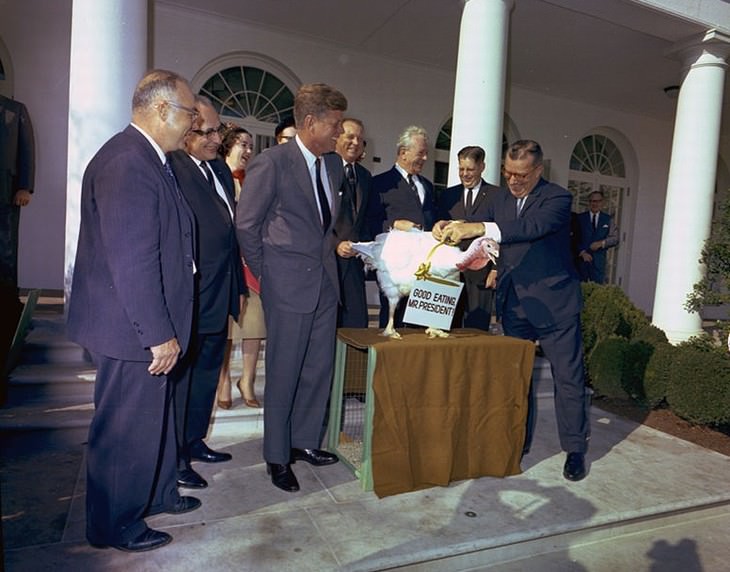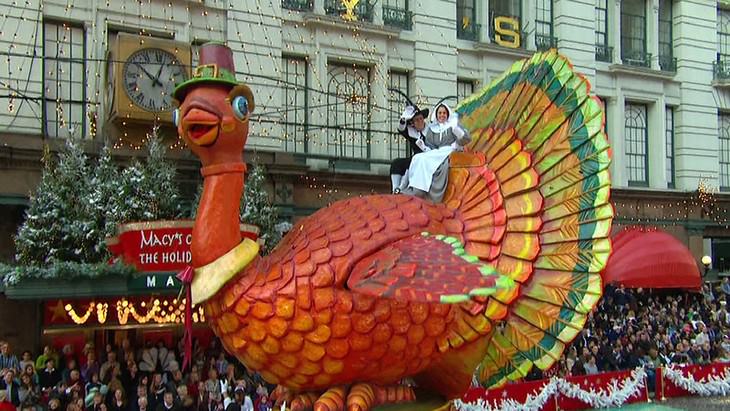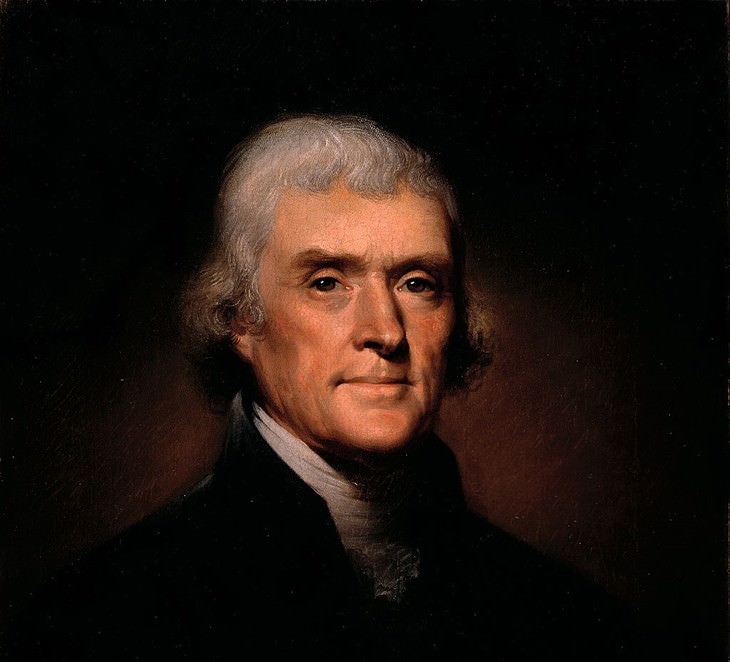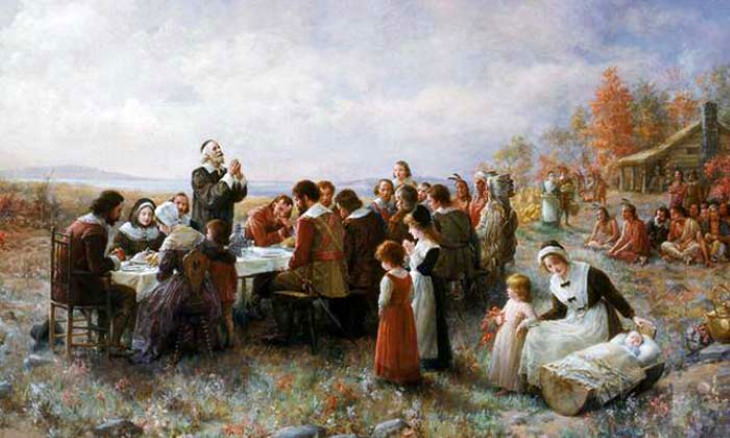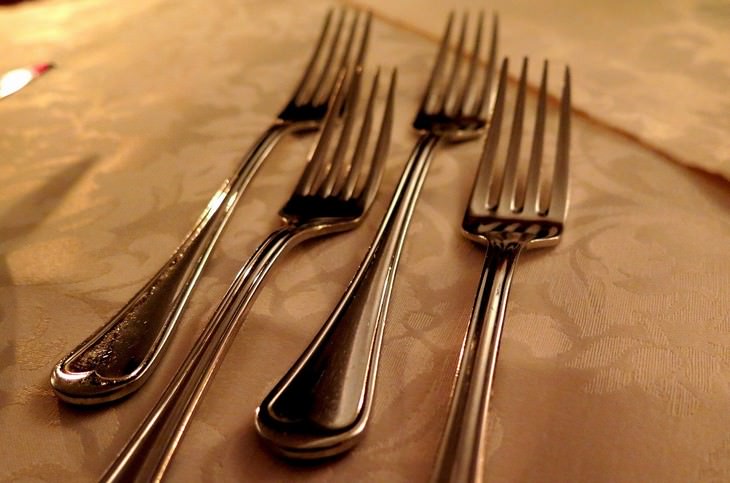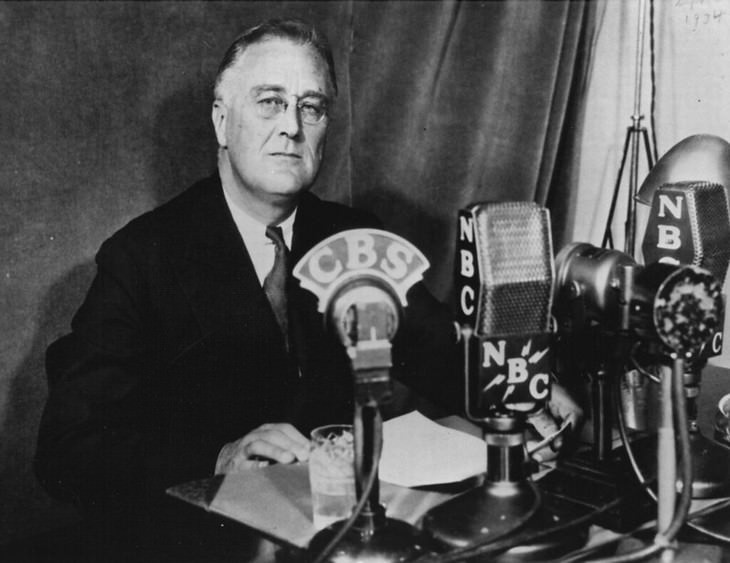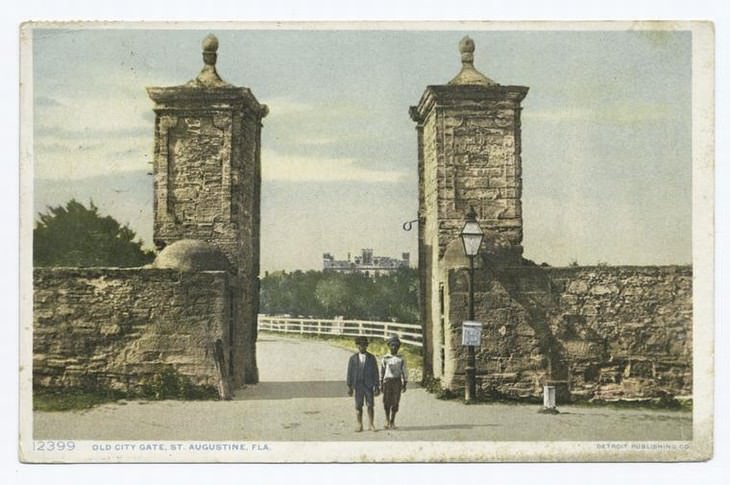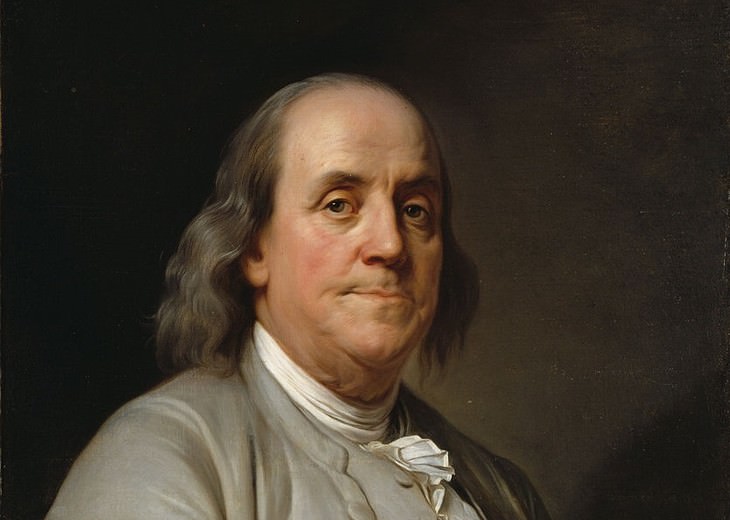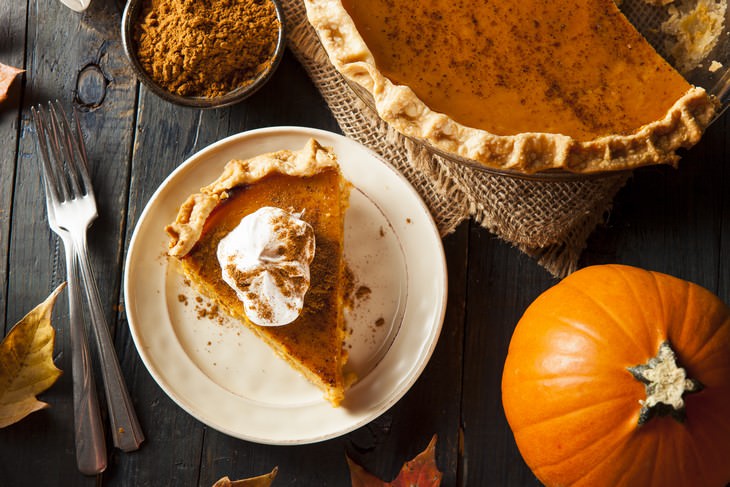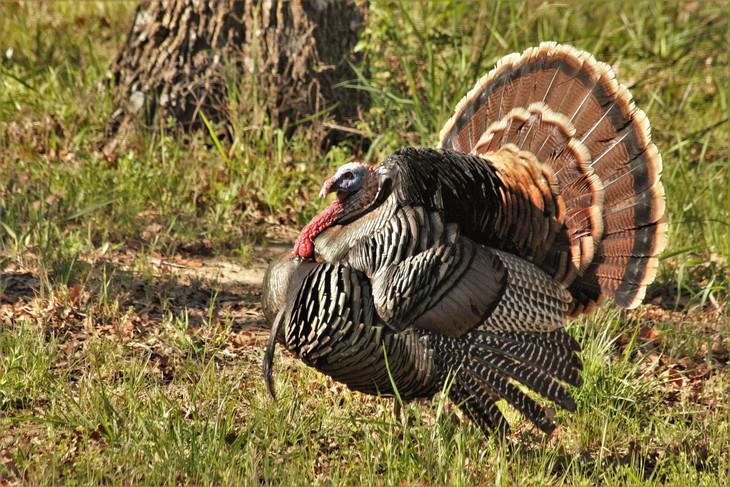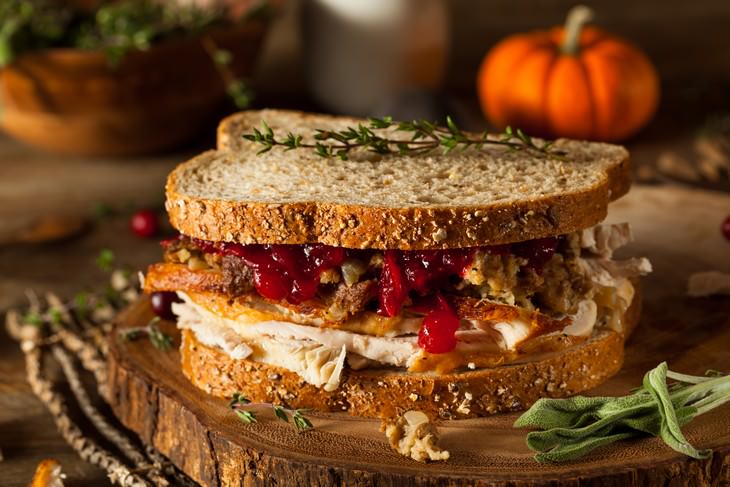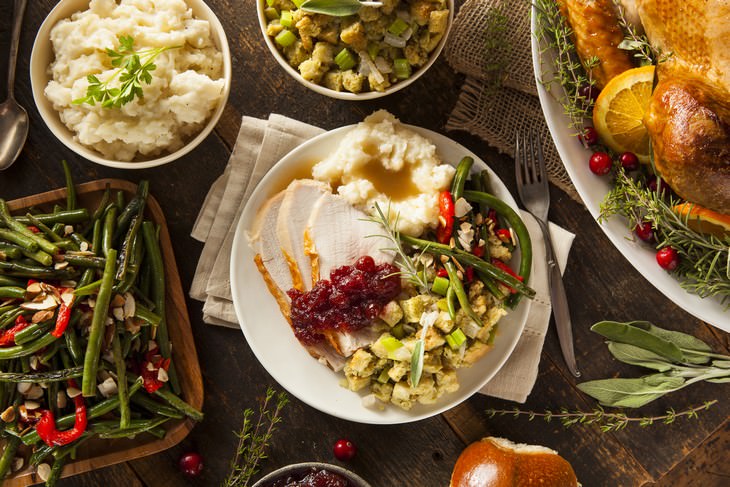1. The First President to Pardon a Turkey
Unexpectedly, the question of which U.S. president was the first to spare a turkey on Thanksgiving is the subject of much debate. Some historians suggest the tradition goes back to Abraham Lincoln, who spared a turkey’s life after his son Tad pled for the fortunate bird’s life.
Others suggest that it was either Harry Truman or John F. Kennedy who introduced the tradition. There’s even a photo of President Kennedy pardoning a turkey wearing a sign that says “Good Eatin’ Mr. President” around its neck.
And while all of these presidents may or may not have spared turkey lives, it was George H.W. Bush in 1989 who initiated the official annual White House tradition of pardoning a turkey. Who knew the history of turkey pardoning is so complicated?
2. What the First Thanksgiving Meal Looked Like
Speaking of turkeys, guess what most likely WASN’T on the menu of the first Thanksgiving meal in Plymouth? That’s right, there’s no mention of the roasted bird at the feast. There were also no mashed potatoes, as these weren’t introduced to North America until later.
Probably the only traditional food present at the first Thanksgiving celebration is pumpkin, as well as many other greens and vegetables grown by the pilgrims. Other foods on the menu that year were deer and local seafood, all brought by Wampanoag.
3. The First Macy’s Thanksgiving Parade Featured Live Animals and No Balloons
The Macy’s Thanksgiving Parade is world-famous for the abundance of enormous balloons shaped like our favorite cartoon characters and animals, but few people actually know that the first parade of this kind didn’t feature these at all.
Instead, the 1924 parade had an animal circus, bands, and floats. As a matter of fact, the first parade wasn’t advertised as a Thanksgiving celebration either, it was held two weeks before Thanksgiving and called “Big Christmas Parade”. Needless to say, the parade was a huge success, and the tradition continues to this day.
4. The President That Refused to Celebrate Thanksgiving
Thomas Jefferson is among the greatest American minds of all time, but did you know that the Founding Father refused to celebrate Thanksgiving and any other fasting periods during his presidency? It's true, Jefferson was the only U.S. president in history to oppose the celebration of the holiday on a federal level.
This is because Jefferson was among the most vocal advocates of the separation of the church and state, and since the tradition involved prayer and introspection at the time, he didn't want to endorse the celebration because it would violate the First Amendment.
5. Do Astronauts Have a Thanksgiving Meal?
The short answer is 'yes', NASA astronauts aboard the International Space Station (ISS) get to enjoy a special meal every Thanksgiving, but they don't get a day off like most Americans. This festive meal includes Thanksgiving staples, such as turkey, mashed potatoes and cranberry sauce, as well as cornbread dressing, desserts, and even apple cider.
6. The First Thanksgiving Celebration in Plymouth Lasted Three Days
Here's another fun fact about the first Thanksgiving that took place in Plymouth, Massachusetts, in 1621. One of the senior leaders of the Plymouth Colony, Edward Winslow, an attendee of this legendary gathering himself, wrote that there were about 150 participants in the celebration and the feast and entertainment lasted for three days.
7. Pilgrims Didn’t Have Forks
Apart from a shortage of basic foods, such as butter and sugar, for example, pilgrims didn't have forks. Spoons and knives were available, though. As a matter of fact, forks didn't gain widespread use in England until the 18th century and before, most people believed that forks were an unnecessary item.
8. President Roosevelt Attempted to Change the Date of Thanksgiving, But It Didn’t Go Well
In 1939, Thanksgiving was officially celebrated not on the usual last Thursday in November, but a week before, on the third Thursday. FDR initiated this change in dates as a way to encourage holiday spending during the years of hardship brought about by the Great Depression.
However, the plan didn't pan out, as this new law caused a great deal of confusion and some states, namely Texas, Colorado, and Mississippi, ended up celebrating Thanksgiving twice. After two years of this madness, the policy was dropped, and the last Thursday of November legally became the official date of the holiday.
9. There Might Have Been an Earlier Thanksgiving Celebration Than the One in Plymouth
It is customary to associate Thanksgiving with the celebration in Plymouth in 1621, but in reality, there were likely several similar celebrations held in other places in North America. For one, Canadians have a Thanksgiving tradition dating back to 1578, the arrival of the English explorer Martin Frobisher in present-day Canada, which he and his crew celebrated with a festive meal.
There's also at least one mention of a celebration very reminiscent of Thanksgiving in St. Augustine, Florida. In 1565, more than half a decade before Plymouth, a Spanish fleet founded the city of St. Augustine, and as a means of celebrating their landing, an estimated 800 settlers have partaken in a festive meal with the native Timucua.
10. Benjamin Franklin Wanted the Turkey and Not the Bald Eagle to Be the National Symbol
While Thomas Jefferson wasn't a fan of Thanksgiving, his fellow Founding Father Benjamin Franklin was, in fact, very fond of one important Thanksgiving attribute - the turkey. When the bald eagle was chosen as the national symbol, Franklin was disappointed, and he even wrote, "I wish the bald eagle had not been chosen as the representative of our country; his is a bird of bad moral character."
This is because bald eagles are, in fact, the bullies of the animal kingdom and often steal food from other birds of prey. Instead, Jefferson suggested another native American bird - the turkey, which, as Franklin suggested, was "a much more respectable Bird".
11. Pumpkin Pie Is Among the Oldest Traditional Thanksgiving Foods
What good is a Thanksgiving feast without some delicious pumpkin pie for dessert? Beyond doubt, Americans are so fond of the scrumptious dessert, they're willing to postpone Thanksgiving for it. In 1705, the town of Colchester, Connecticut, suffered a molasses shortage, and they delayed Thanksgiving for a week because of it.
As a matter of fact, pumpkin pie was a New England staple since the late 17th - early 18th century, making it one of the oldest customary Thanksgiving foods.
12. 'Jingle Bells' Was Originally a Thanksgiving Song
Do you love Christmas songs? We surely do, and we were surprised to find out that the Christmas hit of every season, 'Jingle Bell', was originally written for Thanksgiving.
American songwriter James Pierpont wrote the song in 1857 and called it 'One Horse Open Sleigh', which he believed would make an excellent Thanksgiving tune. As the song gained popularity, it was gradually rebranded for Christmas, and that's how we got this iconic song became what we know today.
13. The Word 'Turkey' Is Related to Turkey, the Country, but in a Strange Way
Here comes another turkey fact. Have you ever wondered why this American bird is named after a Middle Eastern country? Well, it all started long before the first Europeans ever laid their eyes on the bird, when a similar-looking bird called the guinea fowl was imported into Europe from the Ottoman Empire.
Knowing its Turkish origins, Europeans called the bird turkey-hen and turkey-cock. Years later, American colonists started sending turkeys to Europe, and because of the resemblance, the bird came to be known as a turkey.
14. Most Americans Enjoy the Thanksgiving Leftovers More
Believe it or not, there was an actual poll held in 2015 that established that 8 out of 10 Americans actually prefer the celebratory Thanksgiving turkey sandwich to the actual turkey dinner that typically happens the night before. Everyone seems to have their own favorite combination of the customary Thanksgiving ingredients and crafts their own signature leftover extravaganza.
15. How Many Calories Does the Average American Eat on Thanksgiving?
Let's not fool ourselves, Thanksgiving is about food, and primarily about food, and dietary statistics serve as proof of that. Calorie Control Council released information about the food habits of Americans during the holiday, and they established that an average person consumes over 4,500 calories (and approximately 229 g of fat) on Thanksgiving. This is more than double the normal daily intake of calories for women and nearly twice the amount for men!

